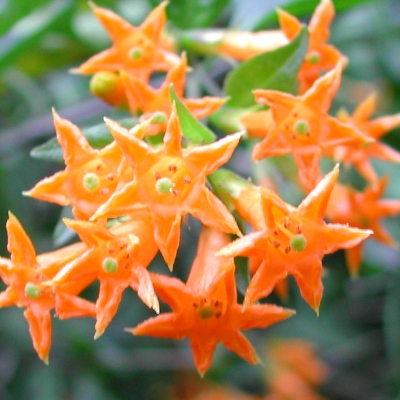"Mango Cestrum"
Germinating the seeds
When to plant -- Plant your seeds when you receive them for best results. Getting started -- You may plant each seed in individual, small containers,
such as seedling starter trays For soil, use a well draining
mix. I use a mix of 1 part
coir fiber Fill the pots with the soil mix and water it until it is evenly moist (but not soggy). Place 1 seed on top in each pot, and sprinkle about 1/8 inch (3 mm) of soil over it. Carefully moisten the top soil layer. Until the seeds sprout, keep the surface soil from drying out. If you place the pots in a plastic container or bag to maintain moisture, leave it open a crack to allow fresh air to enter. They sprout well between 65 to 77° F (18-25°C). I have no information about how they will germinate outside that temperature
range. I recommend placing a minimum/maximum thermometer Keep them in a bright spot out of direct sun. They should begin sprouting within 4 weeks, but allow up to 12 weeks for any slow ones, especially at cooler temperatures. Lighting -- Once your seeds sprout, move them to a bright spot, with protection from afternoon sun. You may use a fluorescent or LED light kept a few inches (10 cm) away while your plants are young. Watering: Once the seedlings are 3 weeks old, you may allow the surface soil to dry out, but aim to keep the rest of the soil evenly moist most of the time. Never let it dry out completely, but also don't keep it perpetually soggy. . Fertilizing -- The first
6-8 weeks, feed every 7 days with a very dilute (1/8 strength) liquid fertilizer. Hydroponic fertilizer is ideal for this, because it is easily absorbed and contains all essential nutrients. I use General Hydroponics Flora fertilizer It's normal for a few of the older leaves to
occasionally turn yellow and drop, but if it seems excessive, the soil may be
too dry down in the root zone. If you're unsure if the soil down in the
root zone has the proper moisture, you can use a moisture meter Growing on.. -- Once your plant is about 4-6 months old, it may be planted in the ground in suitable areas. If you keep it in a container, repot to a larger pot whenever the roots reach the bottom of the container, or after 2 months. Water the soil before repotting, so the soil ball stays together, which protects the roots. Repot again to a larger pot whenever it becomes root bound. The size of the final pot depends on how large you choose to let it grow. A full-sized tree will need an enormous pot, but it may also be kept in a 5 gallon (20 liter) pot if pruned back regularly to keep it small. Climate -- This Cestrum is said to handle down to 25-30 degrees F (-4 to -1°C), and possibly lower. It grows best when protected from all frost. It likes part- to full-sun. In hot areas, it will enjoy some shade during the hottest part of the day. In colder areas, mulch the base well in case it should be struck down by frost. New growth should emerge from beneath the mulch if frost isn't severe. Indoors, over about 40% humidity is best. It can flower all year indoors! Pruning -- You may prune your plant at any time to shape it. To grow it tall and tree-shaped, cut away the side branches on the lower half of the stem. If you prefer a shorter, bushier plant, clip off the leading tip. Flowers appear at the ends of the new growth. Bugs to watch for -- Spider mites (tiny "dots" under the leaves), Aphids (green ones are hard to see), white mealy bugs, and scale (brown discs on the stem - hard to see!). Try using insecticidal soap before using stronger remedies, since some may harm the plant. If you have any questions or problems, feel free to contact me. - Jeff Strange Wonderful Things
|
|||||||||


